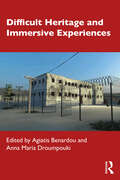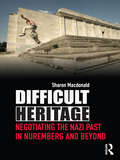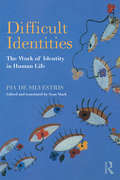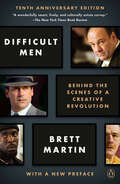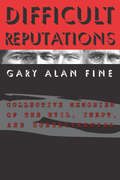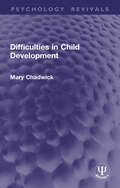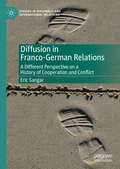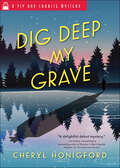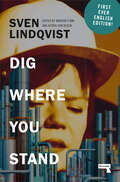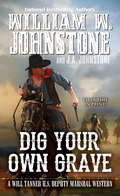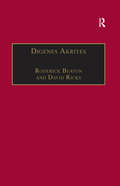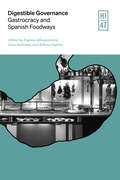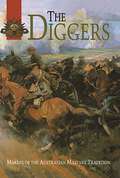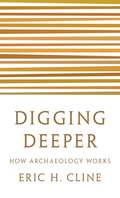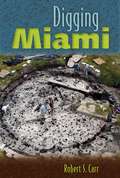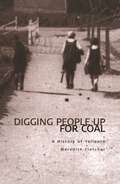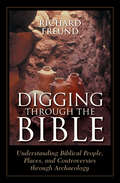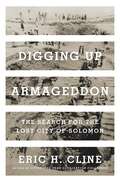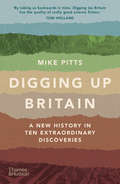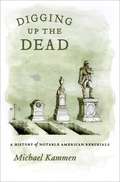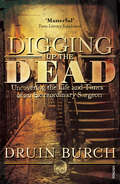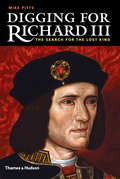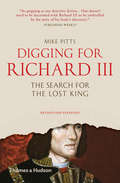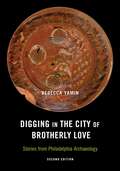- Table View
- List View
Difficult Heritage and Immersive Experiences
by Agiatis Benardou and Anna Maria DroumpoukiDifficult Heritage and Immersive Experiences examines the benefits involved in designing and employing immersive technologies to reconstruct difficult pasts at heritage sites around the world. Presenting interdisciplinary case studies of heritage sites and museums from across a range of different contexts, the volume analyzes the ways in which various types of immersive technologies can help visitors to contextualize and negotiate difficult or sensitive heritage and traumatic pasts. Demonstrating that some of the most creative applications of immersive experiences appear in and at museums and heritage sites, the book showcases how immersive technologies offer the possibility of confronting and disputing presumptions and prejudices, triggering responses, delivering new knowledge, initiating dialogue and challenging preexistingnotions of collective identity. The book provides a conceptual, as well as a hands-on, approach to understanding the use of immersive technologies at sensitive sites around the globe. Difficult Heritage and Immersive Experiences is essential reading for researchers and students who are interested in, or engaged in the study of, cultural heritage, memory, history, politics, dark tourism, design and digital media or immersive technologies. The book will also be of interest to museum and heritage practitioners.
Difficult Heritage: Negotiating the Nazi Past in Nuremberg and Beyond
by Sharon MacdonaldHow does a city and a nation deal with a legacy of perpetrating atrocity? How are contemporary identities negotiated and shaped in the face of concrete reminders of a past that most wish they did not have? Difficult Heritage focuses on the case of Nuremberg – a city whose name is indelibly linked with Nazism – to explore these questions and their implications. Using an original in-depth research, using archival, interview and ethnographic sources, it provides not only fascinating new material and perspectives, but also more general original theorizing of the relationship between heritage, identity and material culture. The book looks at how Nuremberg has dealt with its Nazi past post-1945. It focuses especially, but not exclusively, on the city’s architectural heritage, in particular, the former Nazi party rally grounds, on which the Nuremburg rallies were staged. The book draws on original sources, such as city council debates and interviews, to chart a lively picture of debate, action and inaction in relation to this site and significant others, in Nuremberg and elsewhere. In doing so, Difficult Heritage seeks to highlight changes over time in the ways in which the Nazi past has been dealt with in Germany, and the underlying cultural assumptions, motivations and sources of friction involved. Whilst referencing wider debates and giving examples of what was happening elsewhere in Germany and beyond, Difficult Heritage provides a rich in-depth account of this most fascinating of cases. It also engages in comparative reflection on developments underway elsewhere in order to contextualize what was happening in Nuremberg and to show similarities to and differences from the ways in which other ‘difficult heritages’ have been dealt with elsewhere. By doing so, the author offers an informed perspective on ways of dealing with difficult heritage, today and in the future, discussing innovative museological, educational and artistic practice.
Difficult Identities: The Work of Identity in Human Life
by Pia De SilvestrisEvery human being about to be born is loaned a provisional identity. This identity is embodied in the name they are given, as an invention, internal need, or generational obligation, parental fantasy or delusion. Both the person receiving and the person bestowing the name—and, with it, the provisional identity—are unaware of all this.Interweaving theoretical reflections and clinical histories, Pia De Silvestris illustrates the dramatic nature, the profundity, and the cryptic complexity of the challenges posed by this difficult identity—challenges she has faced repeatedly throughout her psychoanalytic career. She sees the role of transference in psychic and relational life as a "continuous search for the origin", a force that develops continuously through a variety of exchanges and investments, which seek, on the one hand, to weaken the bond to the original object and, on the other, to preserve it until death. Throughout the book’s chapters, we see how it is precisely the product of the transference experience that permits the joint work of identity construction to begin. Transference is always the outcome of an experience of fulfilment and an encounter with the other; and it is desire of the other that promotes the search for the self.
Difficult Men: Behind the Scenes of a Creative Revolution
by Brett MartinIn the late 1990s and early 2000s, a wave of TV shows, first on premium cable channels like HBO and then basic cable networks like FX and AMC, dramatically stretched television's inventiveness, emotional resonance and ambition. Shows such as The Wire, The Sopranos, Mad Men, Deadwood, The Shield tackled issues of life and death, love and sexuality, addiction, race and violence. This revolution happened at the hands of a new breed of auteur: the all-powerful writer-show runner. These were men nearly as complicated, idiosyncratic, and "difficult" as the conflicted protagonists that defined the genre. Given the chance to make art in a maligned medium, they fell upon the opportunity with unchecked ambition. Difficult Men features extensive interviews with all the major players, including David Chase (The Sopranos), David Simon and Ed Burns (The Wire), Matthew Weiner and Jon Hamm (Mad Men), David Milch (NYPD Blue, Deadwood), and Alan Ball (Six Feet Under), in addition to dozens of other writers, directors, studio executives and actors. Martin takes us behind the scenes of our favourite shows, delivering never-before-heard story after story and revealing how TV has emerged from the shadow of film to become a truly significant and influential part of our culture.
Difficult Reputations: Collective Memories of the Evil, Inept, and Controversial
by Gary AlanWe take reputations for granted. Believing in the bad and the good natures of our notorious or illustrious forebears is part of our shared national heritage. Yet we are largely ignorant of how such reputations came to be, who was instrumental in creating them, and why. Even less have we considered how villains, just as much as heroes, have helped our society define its values. Presenting essays on America's most reviled traitor, its worst president, and its most controversial literary ingénue (Benedict Arnold, Warren G. Harding, and Lolita), among others, sociologist Gary Alan Fine analyzes negative, contested, and subcultural reputations. Difficult Reputations offers eight compelling historical case studies as well as a theoretical introduction situating the complex roles in culture and history that negative reputations play. Arguing the need for understanding real conditions that lead to proposed interpretations, as well as how reputations are given meaning over time, this book marks an important contribution to the sociologies of culture and knowledge.
Difficult Reputations: Collective Memories of the Evil, Inept, and Controversial
by Gary Alan FineWe take reputations for granted. Believing in the bad and the good natures of our notorious or illustrious forebears is part of our shared national heritage. Yet we are largely ignorant of how such reputations came to be, who was instrumental in creating them, and why. Even less have we considered how villains, just as much as heroes, have helped our society define its values. Presenting essays on America's most reviled traitor, its worst president, and its most controversial literary ingénue (Benedict Arnold, Warren G. Harding, and Lolita), among others, sociologist Gary Alan Fine analyzes negative, contested, and subcultural reputations. Difficult Reputations offers eight compelling historical case studies as well as a theoretical introduction situating the complex roles in culture and history that negative reputations play. Arguing the need for understanding real conditions that lead to proposed interpretations, as well as how reputations are given meaning over time, this book marks an important contribution to the sociologies of culture and knowledge.
Difficulties in Child Development (Psychology Revivals)
by Mary ChadwickOriginally published in 1928, Difficulties in Child Development was written, according to the author, as ‘a response to many inquiries concerning a source of practical information relating to the development and upbringing of little children from a modern psychological standpoint. It also serves to put forward in a simple and direct manner, without unnecessary intricacies due to the unexplained use of the more specialized psycho-analytic terms, views and discoveries made by Freud and his followers, now scattered in many books that have been written upon this subject… and to condense those which especially touch the matter of child study into a more convenient form for parents, teachers, nurses, welfare workers, and others who are anxious to know what advances and contributions have been made towards the understanding and early education of young children during recent years.’ Today it can be read and enjoyed in its historical context.
Diffusion in Franco-German Relations: A Different Perspective on a History of Cooperation and Conflict (Studies in Diplomacy and International Relations)
by Eric SangarThis book analyses and compares instances of the diffusion of political norms and ideas in the history of Franco-German relations. While this relationship is often described as a history evolving from enmity over reconciliation to friendship, the book uses the concept of diffusion as a complementary analytical perspective to emphasize how political norms and ideas originating in one society have influenced the other, especially in periods of intergovernmental conflict. Established in International Relations to explain transnational normative change in contemporary contexts, the framework of diffusion is heuristically useful to explore how various types of actors have contributed, using analytically different mechanisms, to normative change across the Rhine. The book presents eight case studies featuring various contents and mechanisms of ideational diffusion taken from three contexts of Franco-German history, including the French Revolution, the Franco-Prussian War, and Franco-German rapprochement after 1945. Arguing that phenomena that are often seen as genuinely ‘national’ evolutions, such as German nationalism or the French system of primary education, cannot be understood without taking into account the reception and emulation of norms from across the Rhine, the book should help students and scholars to overcome the limits of methodological nationalism when studying bilateral relationships, in the Franco-German context and elsewhere.
Dig Deep My Grave (Viv and Charlie Mystery #3)
by Cheryl HonigfordLet dead bodies lie…The last thing Vivian expects to see during a garden party at her family's opulent lake house is the love of her life, Charlie Haverman, standing over the body of Hap, a man from Vivian's past, and clutching a pair of blood-covered scissors. But there's no denying the grisly scene in front of her—or that fact that Hap, who Vivian hasn't seen since he abruptly broke off their fling to realize his dream as a pilot years ago—is dead.Could Charlie have attacked Vivian's old flame in a fit of jealousy? It certainly looks that way, although Viv knows Charlie isn't capable of murder. But with witnesses reporting Charlie muttering angry words about Hap hobnobbing amongst the party guests and her family's hostility toward outsiders, Vivian is going to have to figure out how to solve Hap's murder and save the man she loves…before she loses him forever.A country rapidly descending into war and old family secrets come together in the third installment of Cheryl Honigford's beloved Viv and Charlie Mystery series.Viv and Charlie Mystery Series:The Darkness Knows (Book 1)Homicide for the Holidays (Book 2)Dig Deep My Grave
Dig Where You Stand: How to Research a Job
by Sven LindqvistOn the 45th anniversary of its initial publication in Swedish, Sven Lindqvist's polemic on history, politics and power is finally available in English for the first time.This volume brings Dig Where You Stand, Sven Lindqvist's classic text on history, power and politics, to English-speaking audiences for the first time.First published in 1978, Dig Where You Stand is a rallying cry for workers to become researchers, to follow the money, take on the role as experts on their job, and "dig" out its hidden histories in order to take a vital step towards social and economic transformation.A how-to guide that inspired an entire movement, it makes the case that everyone – not just academics – can learn how to critically and rigorously explore history, especially their own history, and in doing so find a blueprint for how to transform society for the better.In a world where the balance of power is overwhelmingly stacked against the working-class, Dig Where You Stand's manifesto for the empowerment of workers through self-education, historical research and political solidarity is as important and relevant today as it was in 1978.
Dig Your Own Grave (A Will Tanner Western #5)
by William W. Johnstone J.A. JohnstoneJohnstone Country. Keeping the West wild. U.S. Marshal Will Tanner is one hell of a manhunter. But this time, he’s chasing six men across three states with one gun and no backup. This isn’t justice. This is a suicide mission . . . DIG YOUR OWN GRAVE It starts with a prison break in Missouri. When notorious bank robber Ansel McCoy busts out, he teams up with five other outlaws. Then he and his gang rob a bank in Kansas. Now they’re crossing state lines into Oklahoma Indian Territory. And that’s where U.S. Marshal Will Tanner steps in. Other marshals from Kansas and Missouri have already lost the trail. Which means Tanner has to go it alone. Deep in the wilderness. Outnumbered and outgunned. One good man against six blood-crazed killers. Even if he manages to survive the elements and find McCoy’s hideout, it’s not just the end of his search. It’s his funeral . . . Live Free. Read Hard.
Digenes Akrites: New Approaches to Byzantine Heroic Poetry (Publications of the Centre for Hellenic Studies, King's College London #Vol. 2)
by Roderick Beaton David RicksCalled variously the ’Byzantine epic’, the ’epic of Modern Greece’, an ’epic-romance’ and ’romance’, the poem of Digenes Akrites has, since its rediscovery towards the end of the nineteenth century, exerted a tenacious hold on the imagination of scholars from a wide range of disciplines and from many countries of the world, as well as of writers and public figures in Greece. There are many reasons for this, not least among them the prestige accorded to ’national epics’ in the nineteenth century and for some time afterwards. Another reason must surely be the work’s uniqueness: there is nothing quite like Digenes Akrites in either Byzantine or Modern Greek literature. However, this uniqueness is not confined to its problematic place in the literary ’canon’ and literary history. As historical testimony, and in its complex relationship to later oral song and to older myth and story-telling, Digenes Akrites again has no close parallels of comparable length in Byzantine or Modern Greek culture. Whether as a literary text, a historical source, or a manifestation of an oral popular culture, Digenes Akrites remains, more than a century after its rediscovery, persistently enigmatic. This Byzantine ’epic’ or ’romance’ has now become the focus of new research across a range of disciplines since the publication in 1985 of a radically revised edition based on the Escorial text of the poem, by Stylianos Alexiou. The papers in this volume, derived from a conference held in May 1992 at King’s College London, seeks to present and discuss the results of this new research. Digenes Akrites: New Approaches to Byzantine Heroic Poetry is the second in the series published by Variorum for the Centre for Hellenic Studies, King’s College London.
Digestible Governance: Gastrocracy and Spanish Foodways (Hispanic Issues)
by Lara Anderson Eugenia Afinoguénova Rebecca IngramThe term &“gastrocracy&” refers to the appropriation of discourses and practices related to the sourcing, preparation, distribution, and consumption of food for political purposes. The intersections of gastronomy and governance, dating in Spain to the last quarter of the nineteenth century, have become highly visible over the past decade, when political debates around nationalism in its different forms have taken the guise of discussions about regional and local cuisines. Concomitant with the rise of the &“slow food&” movement and following UNESCO&’s addition in 2011 of &“Gastronomic Meal of the French&” to its list of Intangible Cultural Heritage of Humanity, public and private associations all around Spain have been established with the goal of achieving recognition by UNESCO for Spanish, Catalan, and other national cuisines. In 2016, Gastro Marca España—an association and a web portal—was launched to raise the profile of food in Spain&’s national brand. Eliciting wide public participation, co-opted for political purposes, regarded as a factor of economic development on any scale, and integrated into every so-called banal nationalism, the production, distribution, and consumption of food are highly relevant for historical analysis. Seeking to encourage a broader discussion about Peninsular gastrocracies, this book brings together an interdisciplinary group of scholars from different sides of the Atlantic and the Pacific who have spearheaded research on gastronomy and governance in Spain.
Diggers
by Chris Coulthard-ClarkHere are over 140 noteworthy military careers, covering the colonial war and the Great War, told by Australia's leading historians. It is a fascinating look at the men and women who established the reputation of the Australian Digger in the annals of world history.
Digging Deeper: How Archaeology Works
by Eric H. ClineFrom the bestselling author of 1177 B.C., an accessible primer to the archaeologist's craftAn archaeologist with more than thirty seasons of excavation experience, Eric H. Cline has conducted fieldwork around the world, from Greece and Crete to Egypt, Israel, and Jordan. In Digging Deeper, Cline answers the questions archaeologists are most frequently asked, such as: How do you know where to dig? How are excavations actually done? How do you know how old something is? Who gets to keep what is found? How do you know what people from the past ate, wore, and looked like? Adapted from Cline's acclaimed book Three Stones Make a Wall, this lively little volume is brimming with insights and practical advice about how archaeology really works. Whether you are an armchair archaeologist or embarking on your first excavation, Digging Deeper is an essential primer on the art of the dig.
Digging Miami
by Robert S CarrThe pace of change of Miami since its incorporation in 1896 is staggering. The seaside land that once was home to several thousand Tequesta is now congested with roads and millions of people while skyscrapers and artificial lights dominate the landscape.Ironically, Miami's development both continually erases monuments and traces of indigenous people and historic pioneers yet also leads to the discovery of archaeological treasures that have lain undiscovered for centuries. In Digging Miami, Robert Carr traces the rich 11,000-year human heritage of the Miami area from the time of its first inhabitants through the arrival of European settlers and up to the early twentieth century.Carr was Dade County's first archaeologist, later historic preservation director, and held the position at a time when redevelopment efforts unearthed dozens of impressive archaeological sites, including the Cutler Site, discovered in 1985, and the controversial Miami Circle, found in 1998. Digging Miami presents a unique anatomy of this fascinating city, dispelling the myth that its history is merely a century old.This comprehensive synthesis of South Florida's archaeological record will astonish readers with the depth of information available throughout an area barely above sea level. Likewise, many will be surprised to learn that modern builders, before beginning construction, must first look for signs of ancient peoples' lives, and this search has led to the discovery of over one hundred sites within the county in recent years. In the end, we are left with the realization that Miami is more than the dream of entrepreneurs to create a tourist mecca built on top of dredged rock and sand; it is a fascinating, vibrant spot that has drawn humans to its shores for unimaginable years.
Digging People Up For Coal: A History of Yallourn
by Fletcher, Meredith... a dramatic account of Australia's most astounding urban story. Professor Tom Stannage This book is about the birth, life and loss of a community. Yallourn was designed in the 1920s as a garden town laid out on 'hygienic and aesthetic principles'. It became a thriving and close-knit community, home to several generations of State Electricity Commission workers and their families. By the 1960s, however, the town was surplus to requirements. It had become an 'area' to be 'cleared'. The Save Yallourn Campaign was long and bitterly fought, but the residents' efforts were in vain. Meredith Fletcher brings to life a community that still exists vividly in memory and imagination. She looks at the intense grief people feel for lost places, and at the creativity that grief can release. Digging People Up for Coal is the first book to examine the process of deconstruction, demolition and detachment of an Australian town. In resurrecting Yallourn from the depths of the open cut, it both celebrates and mourns a lost community.
Digging Through the Bible: Understanding Biblical People, Places, and Controversies through Archaeology
by Richard A FreundA &“masterful and eminently readable&” journey through the fascinating insights and revelations of Biblical archeology (Publishers Weekly, starred review). Many of our religious beliefs are based on faith alone, but archaeology gives us the opportunity to find evidence about what really happened in the distant past—evidence that can have a dramatic impact on what and how we believe. In Digging Through the Bible, archaeologist and rabbi Richard Freund takes readers through digs he has led in the Holy Land, searching for evidence about key biblical characters and events. Digging Through the Bible presents overviews of the evidence surrounding figures such as Moses, Kings David and Solomon, and Mary the mother of Jesus, as well as new information that can help us more fully understand the life and times in which these people would have lived. Freund also presents new evidence about finding the grave of the Teacher of Righteousness mentioned in the Dead Sea Scrolls, and gives a compelling argument about how the Exodus of the Israelites may have taken place in three separate waves over time, rather than in a single event as presented in the Bible.
Digging Up Armageddon: The Search for the Lost City of Solomon
by Eric H. ClineA vivid portrait of the early years of biblical archaeology from the acclaimed author of 1177 B.C.: The Year Civilization CollapsedIn 1925, James Henry Breasted, famed Egyptologist and director of the Oriental Institute at the University of Chicago, sent a team of archaeologists to the Holy Land to excavate the ancient site of Megiddo—Armageddon in the New Testament—which the Bible says was fortified by King Solomon. Their excavations made headlines around the world and shed light on one of the most legendary cities of biblical times, yet little has been written about what happened behind the scenes. Digging Up Armageddon brings to life one of the most important archaeological expeditions ever undertaken, describing the site and what was found there, including discoveries of gold and ivory, and providing an up-close look at the internal workings of a dig in the early years of biblical archaeology.The Chicago team left behind a trove of writings and correspondence spanning more than three decades, from letters and cablegrams to cards, notes, and diaries. Eric Cline draws on these materials to paint a compelling portrait of a bygone age of archaeology. He masterfully sets the expedition against the backdrop of the Great Depression in America and the growing troubles and tensions in British Mandate Palestine. He gives readers an insider's perspective on the debates over what was uncovered at Megiddo, the infighting that roiled the expedition, and the stunning discoveries that transformed our understanding of the ancient world.Digging Up Armageddon is the enthralling story of an archaeological site in the interwar years and its remarkable place at the crossroads of history.
Digging Up Britain: Ten Discoveries, A Million Years Of History
by Mike PittsAn award-winning archaeologist and journalist chronicles England’s history—as told through the country’s recent archaeological discoveries. Digging Up Britain traces the history of Britain through key discoveries and excavations. With British archaeologist Mike Pitts as a guide, this book covers the most exciting excavations of the past ten years, gathers firsthand stories from the people who dug up the remains, and follows the latest revelations as one twist leads to another. Britain, a historically crowded place, has been the site of an unprecedented number of discoveries—almost everywhere the ground is broken, archaeologists find evidence that people have been there before. These discoveries illuminate Britain’s ever-shifting history that we now know includes an increasingly diverse array of cultures and customs. Each chapter of the book tells the story of a single excavation or discovery. Some are major digs, conducted by large teams over years, and others are chance finds, leading to revelations out of proportion to the scale of the original project. Every chapter holds extraordinary tales of planning, teamwork, luck, and cutting-edge archaeological science that produces surprising insights into how people lived a thousand to a million years ago.
Digging Up the Dead: A History of Notable American Reburials
by Michael G. KammenA funeral closes a life story, and a grave in a cemetery marks its end forever. But what happens when those left behind don't agree about the meaning of that story? Or when that disagreement extends all the way to arguments about the final resting place itself? In a surprising number of cases over the years, that's when people have chosen to grab shovels and start digging. With Digging Up the Dead, Pulitzer Prize-winning historian Michael Kammen reveals a treasure trove of fascinating, surprising, and sometimes gruesome stories of exhumation and reburial from throughout American history. Taking us to the contested grave sites of such figures as Sitting Bull, John Paul Jones, Frank Lloyd Wright, Daniel Boone, Jefferson Davis, and even Abraham Lincoln, Kammen explores how complicated interactions of regional pride, shifting reputations, and evolving burial practices led to public, often emotional battles over the final resting places of famous figures. Grave-robbing, skull-fondling, cases of mistaken identity, and the financial lures of cemetery tourism all come into play as Kammen delves deeply into this little-known- yet surprisingly persistent- aspect of American history. Simultaneously insightful and interesting, masterly and macabre, Digging Up the Dead reminds us that the stories of American history don't always end when the key players pass on. Rather, the battle- over reputations, interpretations, and, last but far from least, possession of the remains themselves- is often just beginning.
Digging Up the Dead: Uncovering the Life and Times of an Extraordinary Surgeon
by Druin BurchA tearaway young man from Norfolk, Astley Cooper (1768-1841) became the world's richest and most famous surgeon. Admired from afar by the Brontës and up close by his student Keats, his success was born of an appetite for bloody revolutions. He set up an international network of bodysnatchers, won the Royal Society's highest prize and boasted to Parliament that there was no one whose body he could not steal. Experimenting on his neighbours' corpses and the living bodies of their stolen pets, his discoveries were as great as his infamy. Caught up in the French Revolution, and in attempts to bring radical democracy to Britain, Cooper nevertheless rose to become surgeon to royals from the Prince Regent to Queen Victoria. Setting the past against his own reactions to autopsies and operations, hospitals and poetry, Burch's Digging Up the Dead is a riveting account of a world of gothic horror as well as fertile idealism.
Digging for Richard III: The Search for the Lost King
by Mike PittsThe story of the archaeology behind the dig that found Richard III, told through a fascinating array of photographs, diagrams, and firsthand accounts In August 2012 a search began and on February 4, 2013 a team from Leicester University delivered its verdict to a mesmerized press room, watched by media studios around the world: they had found the remains of Richard III, whose history is perhaps the most contested of all British monarchs. History offers a narrow range of information about Richard III which mostly has already been worked to destruction. Archaeology creates new data, new stories, with a different kind of material: physical remains from which modern science can wrest a surprising amount, and which provide a direct, tangible connection with the past. Unlike history, archaeological research demands that teams of people with varied backgrounds work together. Archaeology is a communal activity, in which the interaction of personalities as well as professional skills can change the course of research. Photographs from the author's own archives, alongside additional material from Leicester University, offer a compelling detective story as the evidence is uncovered.
Digging for Richard III: The Search for the Lost King (Revised and Expanded)
by Mike Pitts"As gripping as any detective fiction. Proof that one doesn't need to be fascinated with Richard III to be enthralled by the story of his body's discovery." —Publisher's Weekly In August 2012 a search began, and on February 4, 2013, a team from Leicester University delivered its verdict to a mesmerized press room and to the world: they had found the remains of Richard III, whose legacy was perhaps the most contested of all British monarchs. Prior to this major discovery, there had been little new information about Richard III for some time. With no new evidence to fuel it, the debate over what kind of man he might have been seemed to have stalled. Thus the story of the discovery of Richard III is a story of the value of archaeology—careful analysis of physical evidence backed up by the latest science and technology—and how it can change our understanding of history. Firsthand accounts from the team that found the king, along with photographs from the author’s own archives and an expanded epilogue incorporating new DNA evidence, augment this compelling detective story as the evidence is uncovered.
Digging in the City of Brotherly Love: Stories from Philadelphia Archaeology
by Rebecca YaminHistoric Philadelphia has long yielded archaeological treasures from its past. Excavations required by the National Historic Preservation Act have recovered pottery shards, pots, plates, coins, bones, and other artifacts relating to early life in the city. This updated edition of Digging in the City of Brotherly Love continues to use archaeology to learn about and understand people from the past. Rebecca Yamin adds three new chapters that showcase several major discoveries from recent finds including unmarked early eighteenth-century burial grounds, one of which associated with the first African Methodist Episcopal (AME) Church, in the oldest part of the city; a nineteenth-century working-class neighborhood built along the path of what is now Route I-95 and was once home to Native American life; and the remains of two taverns found on the site of the current Museum of the American Revolution. Yamin describes the research and state-of-the-art techniques used to study these exciting discoveries. In chronicling the value of looking into a city’s past, Digging in the City of Brotherly Love brings to life the people who lived in the early city and the people in the present who study them.
